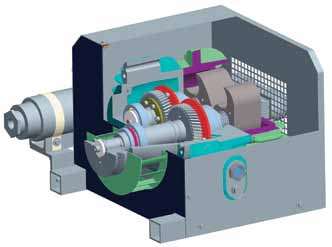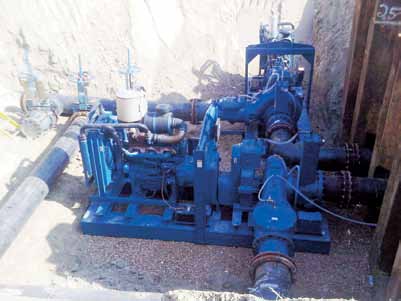Increased efficiency, higher air handling and fast, automatic priming are provided with new technology.
The groundbreaking oil-less vacuum technology (OVT) priming system offers multiple improvements to traditional vacuum priming systems. While both allow for a basic pump to prime automatically, the OVT does this more efficiently with lower maintenance and higher air handling for faster priming. In addition, the OVT system's non-contacting rotors eliminate internal wear, which increases longevity and provides the reliability of no decrease in performance over time.
The OVT system offers lower maintenance and operating expenses because the system is dry running—no re-circulating oil is needed. Eliminating the oil, in turn, eliminates any possible pollution that traditional priming systems may experience—offering a much-improved, eco-friendly alternative to prior technology. Traditional vacuum priming systems require service every 5,000 hours. The OVT priming unit only requires service every 20,000 hours, which is four times less maintenance.

The OVT priming system
Not only does the OVT system have high vacuum capability with deeper suction lifts of 28.4 inches of mercury, but it also maintains a high vacuum at lower speeds. This air-cooled priming system has no water levels to check and no cooling system to maintain unlike traditional vacuum priming systems. These capabilities allow the OVT priming system to perform in a variety of applications from sewer bypassing to wellpoint dewatering.
Most interestingly, the OVT priming system is tolerant of accidental liquid carryover. Prior vacuum priming systems would be damaged if liquid carried over. In turn, this makes the OVT priming system the most rugged priming system on the portable pump market today.

Two OVT pumps on the sewer bypass application
Proven Technology
Research and development of the OVT priming system began in late 2006. Designing, building and testing prototypes began immediately following a full feasibility study. Thousands of hours in durability and field testing lead to the validation of the ideal technology to release for consumer availability.
Recently, the manufacturer provided three OVT pumps for a sewer bypass project near Highway 49 South in Richland, Miss. The customer, Hemphill Construction, has had several highly successful sewer bypass projects with the manufacturer in the past. Initial priming times were a concern for this project. Therefore pumps with OVT were recommended since they provide high CFM (air flow) which allows for fast initial priming and re-priming times.
“When we delivered one of the OVT pumps, we tested the unit with a 20' suction lift,” says Jim Templeton, the manufacturer's sales representative. “From totally dry, the unit primed with the engine idling, in just less than a minute.”
Since the line to tap into the initial bypass was 38 feet deep, the contractor excavated a pit to lower the pumps to an elevation with a manageable suction lift. The OVT pumps not only fit the anticipated duty point very well, they minimized the number of pumps that would need to be placed in the excavated pit.
The four month project used the three 18-inch OVT pumps to bypass a peak flow of 30 MGD (million gallons per day) while the 48-inch West Rankin Sewer District gravity pipeline was being slip-line repaired, where a smaller pipe is placed within the larger, deteriorated pipe. Each Thompson Pump provided was capable of 11,000 gallons per minute (GPM), 160 feet of head and solids-handling up to 4 inches.
The pumped sewage was rerouted using two 1,500-foot lines of 18-inch high-density polyethylene (HDPE) pipe that connected into the force main line that lead directly to the treatment plant. Once these HDPE pipes delivered the sewage into the force main line, the Thompson OVT pumps continued to push the sewage down the line almost 6 miles to the Savanna Street Water and Wastewater Treatment Plant in the neighboring city of Jackson.
“The OVT pumps performed to a ‘T,'” said Templeton.

Curve of pump with oil-less system (September 2010)
In Summary
The OVT priming system provides:
- Dry running—no sealing or lubricating oil is needed in the vacuum compression chamber.
- Ultra low maintenance—the unit only requires servicing at 20,000 hour intervals.
- Extremely high air handling—faster priming times (97 cfm).
- High vacuum capability—deeper suction lifts (28.4 inches of mercury).
- Efficiency—low horsepower for high cfm.
- Longevity—low life cycle costs, non-contacting rotors eliminate internal wear.
- Air cooling—no water levels to check and no oil system to maintain.
- Rugged—tolerable to liquids, dust, and modest solids.
- Reliability—no decrease in performance over time.
- Performance—maintains high vacuum at lower speeds.
- Versatility—can be used in a variety of applications from sewer bypassing to wellpoint dewatering.
- Economical—operating costs are low because of the maintenance-free design and the reduced energy requirement, made possible by the high-volumetric efficiency along with a zero friction chamber.
- Eco-friendly—no sealing or lubricating oil provides for no oil pollution or smoke.
- Guaranteed performance.
The OVT priming system can be added to certain centrifugal pumps.
Pumps & Systems, October 2011

